The first of the team to leave was Richard Burton. He'd had an offer to join publishing giant IPC to work on one of their hugely successful boys' adventure comics.
Then, after a clash with Marvel UK management, Dez parted company with Marvel and went on to set up Quality Communications, which published the ground-breaking Warrior, in the early 1980s, and made a star of Alan Moore.
Richard had been replaced as Editor of the weekly line by respected comic strip artist Paul Neary. By default, I inherited the monthly magazines. The first issue of Starburst edited by me was number 20, devoted to the role of the heroine in science fiction movies through the decades. A sort of Loaded of the SF world. So popular was this simple idea that it became an annual event and has been much imitated over the intervening twenty years.
The issues that followed represented a learning curve for me. It was the first time that I'd edited a magazine solo.But I'd been taught well by my old mentor Dez and pretty soon I'd relaxed into being a sort of proxy reader of the magazine. I figured I'd just get the writers to produce the sort of stuff I wanted to read and things would be all right.
And if they weren't . . . well, at least I'd done my best.
One of the first changes I made to Starburst was to cover horror movies. House of Hammer/Horror was no longer being published and there was no horror movie magazine available at the time, so I figured we might be able to pick up a few horror fans as readers that way.
The first horror movie we covered was Zombie Flesheaters in Starburst 21. Nothing like starting with a bang!
